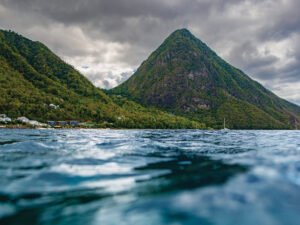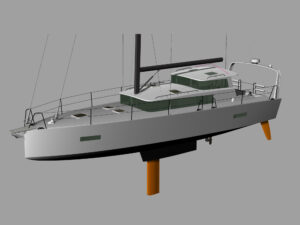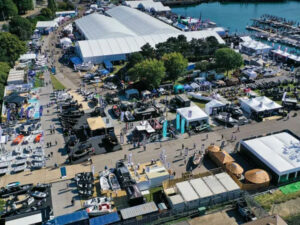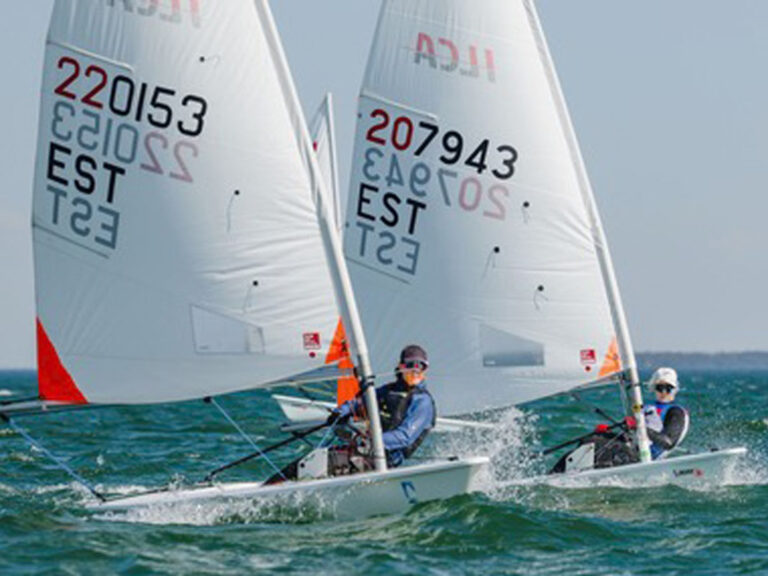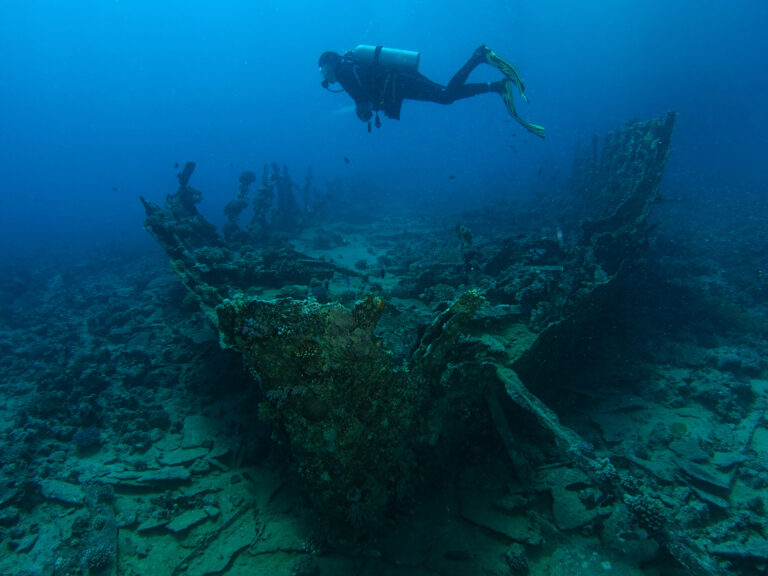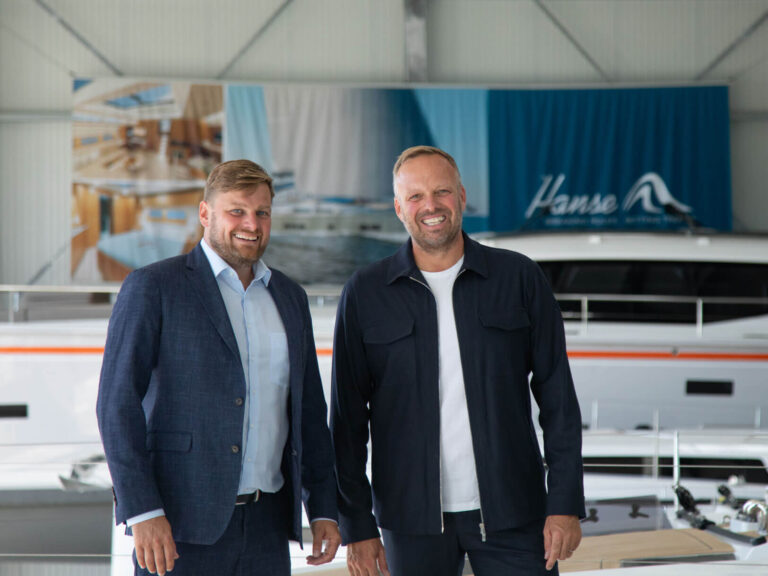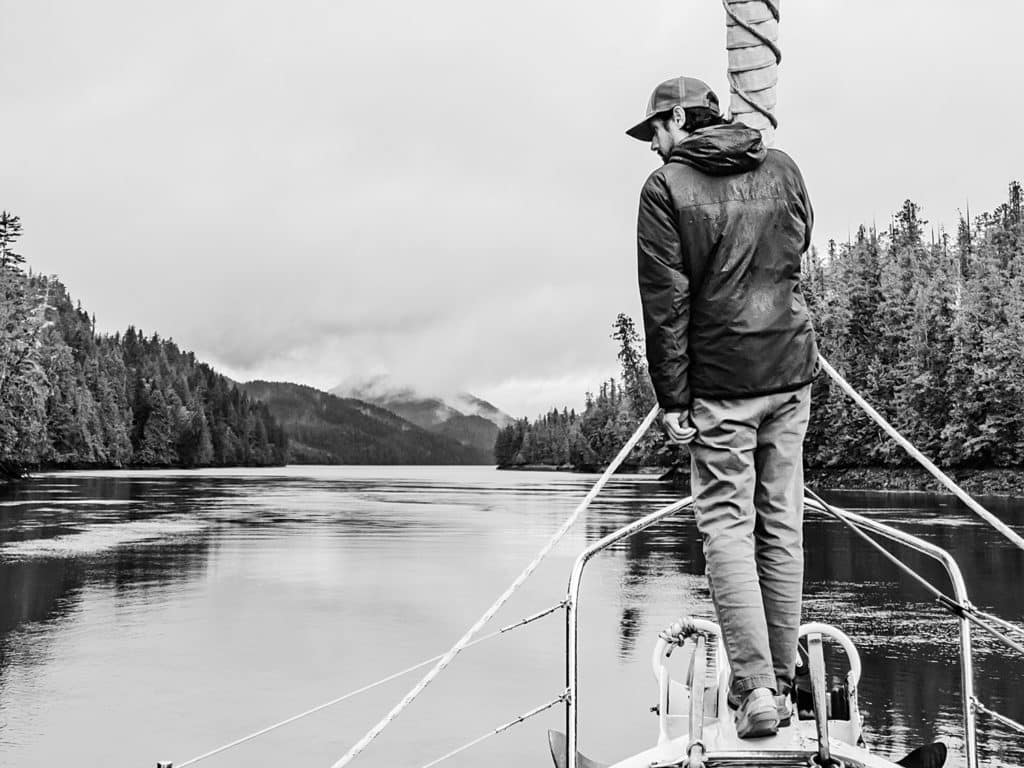
The thrum of the diesel engine reverberated through the teak deck and up through the soles of my heavy furry boots as Passing Cloud slipped smoothly through the almost-black waters of British Columbia’s Seaforth Channel. The Heiltsuk First Nation community of Bella Bella faded into the distance as we headed out on our adventure in the Great Bear Rainforest. Overhead, the skies were leaden, promising rain, much to the joy of the crew.
As a fair-weather sailor, the idea of a rainy week aboard the 71-foot classic wooden schooner sent chills up my spine. But I understood their joy and simply added another layer of clothing.
After all, when summer turns to fall, and wild Pacific salmon migrate toward their native rivers for spawning, “pray for rain” is the cry echoed all around the area. This year, the rivers were too low, causing major concern that the annual rains would be coming too late for the iconic fish.
Salmon are the lifeblood of the area’s First Nation people, who rely on the yearly migrations not just for food, but also as the symbols of abundance, fertility, prosperity and renewal. This all tied into Passing Cloud‘s overreaching commitment of connecting people with nature, fostering stewardship, and reducing their carbon footprint.
This was my second trip aboard Passing Cloud. A couple of years earlier, I was lucky enough to experience a voyage to Haida Gwaii—also known as the Queen Charlotte Islands—an experience I won’t ever forget. When this trip presented itself, I jumped at the opportunity to explore the Great Bear Rainforest in mainland British Columbia.

The Rainforest is a wild and dramatic region, one of the world’s largest, intact temperate forests that covers more than 24,000 square miles of land and sea. The spectacular scenery forms a backdrop for whales, dolphins, bears, wolves, sea lions, sea otters, and a vast variety of pelagic birds that depend on the health and viability of the wild Pacific salmon.
Hence the joyful prospect of rain after the dry summer.
Passing Cloud‘s crew included Russ Markel, skipper and owner of the boat and a marine biologist; Liam Ogle, the widely traveled and experienced first mate; Erin Vickars, our super-talented Red Seal chef (the designation comes from a prestigious Canadian internship); and Briony Penn, our onboard expert with an encyclopedic knowledge of the flora, fauna and people of the area. And then the six guests, including me, who had flown in from around the world to experience this once-in-a-lifetime trip. They included a couple from South Africa, a single woman from England and a local couple from Vancouver.
It felt good and familiar to be back on board, and as I looked around, I noted the upgrades and other changes that had been made during the intervening couple of years. Most significantly, a set of new, flexible solar panels covered the top of the pilothouse, which significantly increased battery life. They also significantly decreased the boat’s carbon footprint, a major component of Passing Cloud‘s mission.
One of the unique aspects of these adventure trips is that although there is a basic timeframe and itinerary, the tides, weather and animal sightings rule. Insider knowledge and boat-to-boat communications play a huge part, with unexpected sightings and information constantly (and sometimes drastically) altering our route. But the location of whales and other animals one day can change by miles overnight, so there is never a guarantee that the animals will be sighted. The biggest challenge was to spot the elusive “White Spirit,” or Kermode bear, a rare subspecies of the black bear.

According to legends of the Gitga’at and Kitasoo Native peoples, Raven, the creator of the rainforest who made everything green, decided to make 1 in 10 black bears white, to remind him of the time when the world was white with snow and ice. Raven decided to set aside a special area of the world for these bears, which is now known as the Great Bear Rainforest.
The general itinerary was to go west, then turn north around Ivory Island, zigzagging up and around Princess Royal Island; proceed east and then south through the Fiordland Conservancy, ducking between Susan and Dowager islands; and then head a few miles north to Klemtu, an isolated fishing village. Then it would be south, and finally back east to end up where we started, in Bella Bella.
Before we were even underway, the steady flow of food began. Erin, our young chef, produced gourmet meals around the clock. From early-morning coffee to a late-evening dessert, the food kept coming. As a professionally trained chef, Erin didn’t simply prepare food—she presented beautifully plated meals.
A new feature of these trips aboard Passing Cloud is that each dinner is themed to express the experiences of that particular day. We had appetizers that depicted birds’ nests on the day we saw the sandhill cranes. And a chocolate-ganache dessert with tiny bear prints on the first day we saw bears. We even enjoyed unique woven cucumber strips topped with creme fraiche and salmon roe, the weaving representing the baskets used by the people indigenous to the area.

But more important, the choice of foods pointed to the sustainability aspect of the trip. As much as possible, food and supplies are sourced locally, which is a feat unto itself, given the remote location. During our eight days aboard, we saw only one other community, Klemtu, besides our departure port of Bella Bella. The menu included fresh local seafood and vegetables, supplemented with foraged greens from shore excursions. Several dinners were vegetarian, going along with sustainability, but Erin is very conscious of nutrition, and the meals were completely balanced. Two large ice chests and a freezer on deck, packed with supplies that were either flown in or brought in by boat, formed the basis of the menu. We were so well-fed that at one stage, I had to ask for smaller portions and declined the between-meal snacks.
As we wove our way up the channel on that first day, the only other vessels we saw were a couple of small commercial fishing boats. Cruising slowly, binoculars and cameras at the ready, we passed by the classic Ivory Island lighthouse, its fresh white walls and bright-red roof shining in the sun that peaked out from behind the lowering clouds.
And then…our first humpback whale sighting. Sharp eyes spied the spray shooting into the air, then the curve of an enormous back slipped above the water, followed by the iconic tail flap. Although they were a distance away, cameras snapped madly. Little did we know how plentiful these gentle giants are in the area and how many we would see.

The humpbacks were hunted to near extinction in the mid-1900s, but after a whaling ban in 1965, the population has grown to between 3,000 and 5,000, according to the Department of Fisheries and Oceans. Part of Passing Cloud‘s mission is to educate guests about the wildlife of the area, and true to that mission, Briony produced a large, notated poster of whale flukes, each identified by its particular markings. We compared our own images with those on the poster with some success. Unfortunately, many of the identifying markings are man-inflicted, because these slow-moving giants are often injured by boats and caught in fishing nets. A recent law requires boats to remain 300 feet from the whales, but because they remain submerged for extended times, it’s sometimes impossible to avoid them, as we later discovered.
Our days took on a certain rhythm. Early-morning coffee, watching the sun rise over the densely forested hills and islands, then perhaps a Zodiac excursion ashore before a hearty breakfast underway. Breakfast time often included a recap of the previous day and a look at the chart for the current day. Then a lunch stop, and on sunny days, we’d enjoy our meal on deck. After lunch, another shore excursion to go looking for bears, then back to Passing Cloud for a snack before our spectacular dinner. Conversation around the dinner table was always lively, with the crew regaling us with local-history observations and personal adventures.
Because of the inclement weather, preparing to go ashore was always a bit of a mission. First came the long underwear and wool socks. Then layers—on top we had a shirt, sweater, coat and rain jacket, and then added rain pants over jeans. On top of all that were knee-high boots, gloves and hat, and a lifejacket. By the time I was suited up, I felt like the Michelin Man. Glamour was not a priority aboard Passing Cloud.
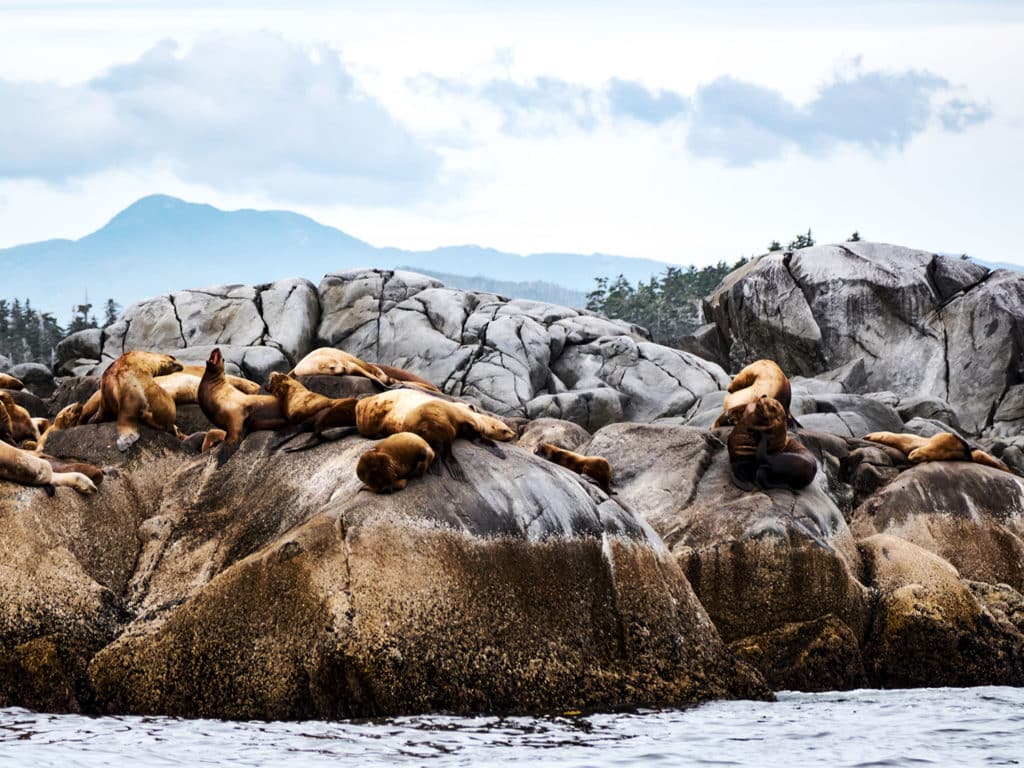
Of course, no one was required to make any of the shoreside excursions, but even on a couple of the days with heavy rain, we all suited up, climbed into the Zodiac for a short ride, then waded ashore, carefully navigating the rocky foreshore. Either Russ or Liam accompanied us, but Briony, our onboard naturalist, was on every excursion, providing an ongoing show and tell. We learned the ways of the black bears, of the sandhill cranes, and how to prepare special tea from what to the untrained eye were just twigs. She showed us wild blueberries, and on occasions when chef Erin came ashore, she and Briony foraged for sea asparagus and other local greens that later that day would grace our dinner plates.
Going ashore was always an adventure. For my inexperienced eye, the trails we hiked were almost impossible to see. But as Russ and Briony led us on these forays into the forest, we learned that these were bear trails, which in itself was a bit disconcerting. We clambered up and down hills, over fallen trees, ducking under bushes and limbs that hung low over the trail.
On one of the more memorable excursions, after landing in a narrow, rocky inlet and wading ashore, with Russ in the lead and Briony bringing up the rear, we hiked to an area known for bears. By this time, the rains had increased the river’s flow and there was hope that the salmon would be starting to make the migration upriver. And if that were the case, then the bears would be ready and waiting for them.
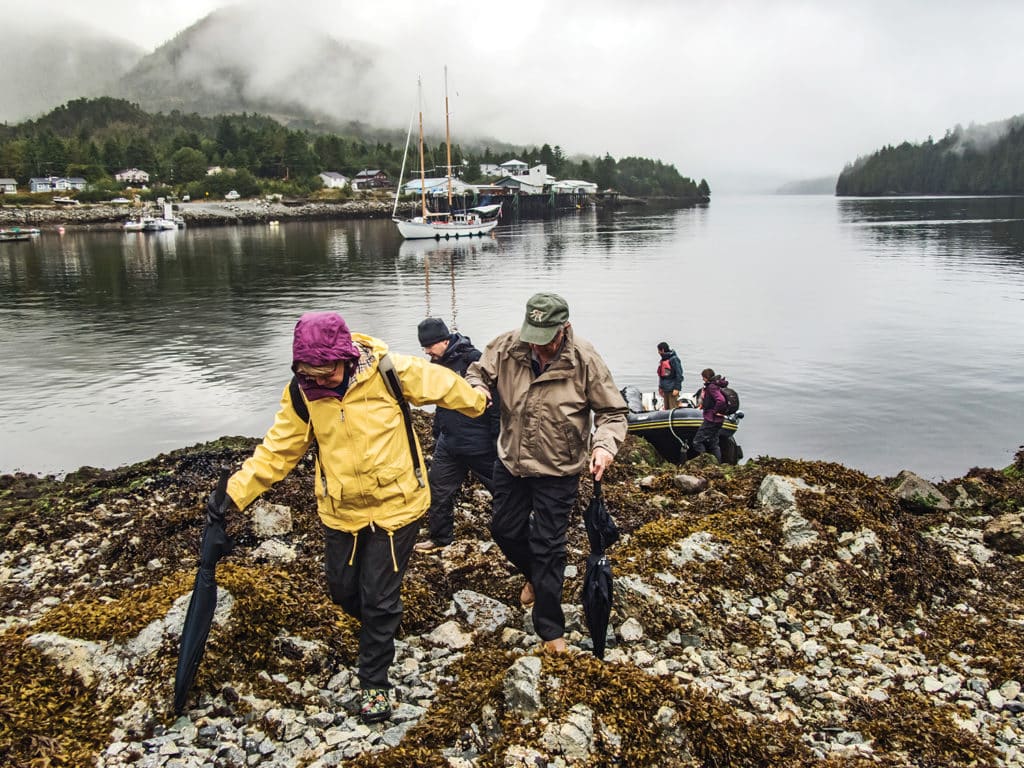
We broke through the dense growth and found ourselves high on a bank overlooking a raging waterfall that tumbled into a rocky pool. This scenario, we learned, was ideal for watching for bears. As we sat quietly up among the trees and waited, a black bear silently materialized on the rocks below us. It ambled along the riverbank and made its way to the pool, where it seemed to contemplate the situation, and then leaped into the water, apparently searching for salmon. As we sat in awe, the bear clambered ashore and spent a while exploring the area. And for a heart-stopping minute, it looked like it was going to climb the bank to depart on the bear trail we had just used. “Just move back from the trail and stay completely still,” Russ told us. The bear seemed to consider whether to come our way, and happily, it chose to go back the way it had come.
Although we weren’t lucky enough to spot a Spirit Bear during our time aboard, we did spend time watching a mama grizzly bear and her three cubs foraging and fording a wide stream to pick wild apples, watched over by literally dozens of eagles that roosted in the trees overlooking the feeding sites. The three cubs acted like typical youngsters, roughhousing and rushing flocks of seagulls nearby, causing them all to take flight.
The area we sailed was so remote that on a couple of late afternoons, coming into our overnight anchorage, we almost felt affronted by the sight of another boat there before us. And traveling through the narrow channels and fjords, we seldom saw any other vessels, so when we spied the Alaska Marine Highway ferry that runs between Port Hardy and Prince Rupert heading our way, we were like school kids, waving to it as it traveled south.
Twenty-plus years ago, this vast area was threatened by overlogging and decimation of the First Nations that have called it home for centuries. During those years, a historic agreement was reached between the B.C. government, the First Nations and environmentalists, which is a road map for other regions of the world. Collaboration resulted in the 2016 Great Bear Rainforest Land Use Order and Great Bear Rainforest (Forest Management) Act, a consensus-based decision-making model that works toward protecting both the cultural and ecological heritage for future generations.
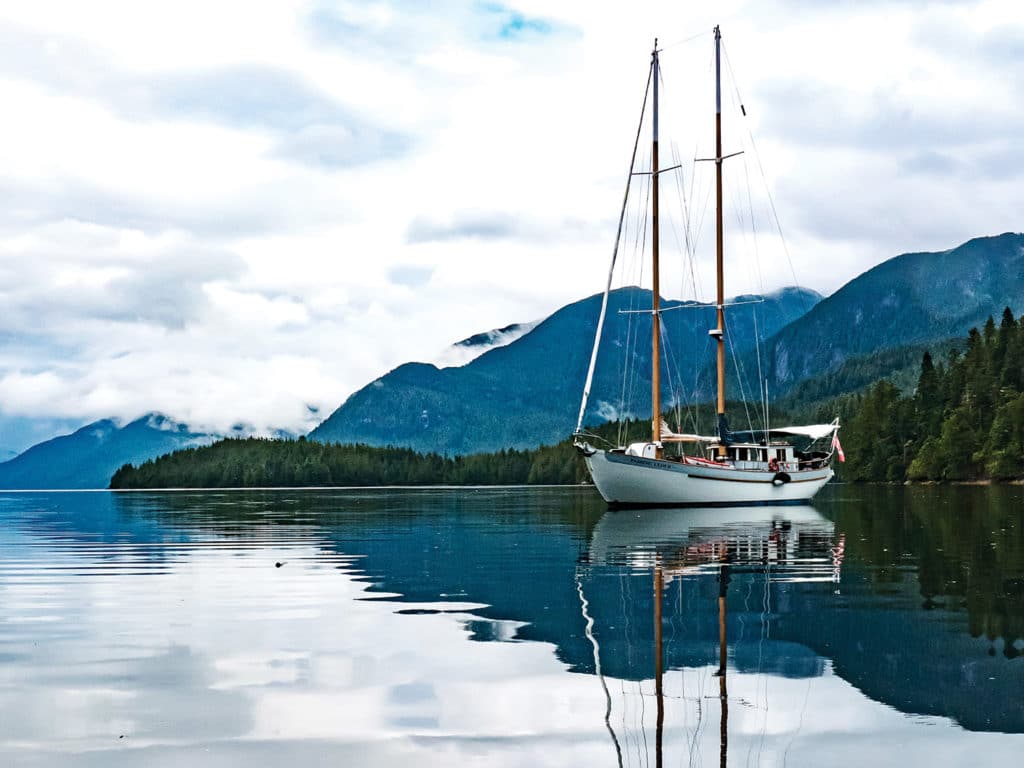
Klemtu, the only community we visited, is a beneficiary of the historic agreement. We were fortunate to visit the longhouse and hear the history of the Kitasoo tribe of Tsimshians, originally from Kitasu Bay, and the Xai’xais of Kynoch Inlet, people who make the enclave their home. And we toured a community-development project, the Spirit Bear Lodge, where our one trinket-hungry crewmember was able to buy a memento. Klemtu is accessible only by boat or seaplane, and very infrequent ferry service.
The Great Bear Sea is teeming with life both above and below. At last count, 210 species of plants, 80 types of birds, 190 marine invertebrate species, 50 fish species, 20 kinds of mammals and reptiles, and 120 different kinds of seaweed are found in this magical place. We cruised the shoreline and meandered through the rocky channels, some so narrow that Liam spent his time as lookout on the bow, ensuring that Russ avoided the numerous unmarked hazards. We passed by a scattering of huge rocks, covered in Steller sea lions, and hung there for a while, simply observing (and smelling) them as they enjoyed the sun that had reappeared. Being so close to shore, we came close to flocks of sandhill cranes without disturbing them. We sailed with a pod of Dall’s porpoises as they went into a feeding frenzy right off the bow. Salmon swam and jumped at the river entrances, waiting for the rain. And overhead, we saw an ever-changing kaleidoscope of peregrine falcons, bald eagles, sandhill cranes, murrelets, shearwaters, cormorants and oyster catchers.
RELATED: The Wild West Coast of Vancouver Island
On our penultimate day aboard, the weather cleared, the sun came out, and the forests and horizons that had looked dark and forbidding lightened up as we sailed under clear skies back toward Bella Bella. It felt so good: the sun warm on my face and the boat so responsive and alive as I drove it to our final night’s anchorage.
Picking my most memorable moment of the trip is difficult. There were so many amazing sights and sounds, but being a Pisces, I have to say that one particular encounter is first and foremost in my memories.
We had numerous humpback whale sightings during the trip, and they were always a thrill to see. But about halfway through the journey, we saw a pod off in the distance as we cruised north. Suddenly, we were surrounded by several of them, really close, almost within touching distance. Russ immediately shutdown the engine, and we simply drifted for an hour or more, with whales cavorting all around us. They came up alongside, rolling slightly, one eye checking us out, then made a slow move underwater, sometimes directly from port to starboard, beneath the boat. Standing at the stern, I watched in amazement as the wheel turned all by itself as the whales brushed against the rudder. Standing there, getting completely drenched in the spray as the humpbacks blew close aboard on either side, I felt as close to nature as anyone could ever be.
Then, sadly, as if on cue, they all sounded, and we were left alone on a silent sea with our most amazing memories.
*Susan Colby is an independent photojournalist and editor who follows the sun, avoiding winter at all costs, while writing about sailing, travel and craft distilleries. *
Heading For Outer Shores

Passing Cloud is a William Roué-designed 71-foot schooner, built in 1974 in Victoria, British Columbia, by Brian Walker. Although designed specifically for cruising, it proved to be surprisingly fast, winning many races in the Pacific Northwest, including the 1984 San Francisco Master Mariners Race, the first non-American boat to do so. Considering Roué also designed the famous schooner Bluenose, this wasn’t surprising. Passing Cloud logged thousands of miles over the years, down the West Coast and south to Tahiti, before returning home to British Columbia, where in 2012 it was bought by Russ Markel, founder of Outer Shores Expeditions, a small-ship, niche-adventure travel company operating wildlife, wilderness and cultural expeditions in British Columbia.

